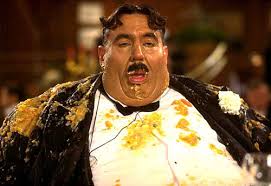
by Kristi Jain | Aug 31, 2022 | Uncategorized
Today’s blog asks a question. Are you like many people who periodically jumps on the “healthy eating, quit drinking, I’m gonna get in better shape” bandwagon? You know the drill. We get enthused, have good intentions and many actually execute. We do it until…we don’t.
EBB AND FLOW
As you’ve probably already experienced, enthusiasm ebbs and flows. Last week I read an article that asked an interesting question. “Are you gaining weight eating too much healthy food?” If you are chillin’ on the couch scarfing a bag of chips right now, the answer is clear.
IT’s POSSIBLE…
It is possible to gain weight by eating too much healthy food. Tons of fiber, oceans of water, lean protein, fruits, veggies, whole grains, nuts, healthy fats are what we understand leads to better health and weight loss. Right? Not so fast. Too much of a good thing is not always a good thing. You don’t have to be meticulous about counting calories but remember, calories do count.
TOO MUCH OF A GOOD THING
The fact is many healthy foods are loaded with calories so be mindful on your health journey. An article I read on Betterme.com helps break down some facts for us. To synopsize, if you are not losing weight or getting your desired result, there could be various reasons behind the problem. One of them being you simply eat too much healthy food.
BALANCE
Balance is critical. In order for your body to function correctly, your diet should provide you with vitamins, macro nutrients and minerals. A healthy diet is the corner stone for weight loss. A balanced diet can reduce obesity as well as decrease the risk of chronic diseases such as cardiovascular disease, diabetes, high blood pressure and cancer.
ARE YOU NUTS?
I am one of those folks who eats nuts every day. Nuts are beneficial to your health unless you have a nut allergy. They are fairly high in calories. For example, one cup of macadamia nuts can have as much as 950 calories. Note to self, weight loss is not achieved by scarfing too many nuts!
BE CAREFUL
Thirty years ago, on one of my many weight loss excursions, the trend was low or no fat. For me it was highly successful however I now understand it was the fact the I drastically reduced calories and dedicated myself to consistent workouts, hence the success. Yes the pounds seemed to melt off but it little or nothing to do with the low fat craze. Keep in mind that products that lack fat are often loaded with sugar so it doesn’t taste like a cardboard box.
OVEREATING
It is difficult to overeat non-starchy vegetables because they contain lots of fiber and water. Potatoes and corn are a different story. Remember there is a difference between lean protein and a slab of prime rib. It all comes down to choices. The truth is we don’t have to suffer to lose weight.
HDD
If your journey to better health includes diagnostic ultrasound, call us at 505-350-3397.

by Kristi Jain | Aug 17, 2022 | Uncategorized
Thanks for taking time to read today’s blog. As I searched for inspiration this week, I became aware of the morning news playing in the background. It is the same crap, different day. Enough already! I believe we are all at an unbelievable point of saturation. With new COVID variants, monkeypox, inequality, violent protesting and unrest, we could all use a beacon of hope.
NATIVE AMERICAN PROVERB
I recall reading an old native American proverb many years ago. I had to research a bit to find it. It says, “No tree has branches so foolish as to fight amongst themselves.” So, the question becomes, why are we fighting amongst ourselves?
BE PART OF THE SOLUTION
Psychology says when you focus on problems, you will have more problems. When you focus on possibilities, you’ll have more opportunities. I mistakenly quoted Brenee Brown in a recent quote. She said Sonya Renee Taylor deserves the credit for the following that I believe is worth repeating in case you missed it.
NORMAL
“We will not go back to normal. Normal never was. Our pre-Corona existence was not normal other than we normalized greed, inequality, exhaustion, depletion, extraction, disconnection, confusion, rage, hoarding, hate and lack. We should not long to return my friends, we are being given the opportunity to stich a new garment. One that fits all of humanity and nature.”
WHAT A DIFFERENCE A DAY MAKES
This quote impacted me when I originally read it, but it is especially impactful this week as we watch our planet become diseased and observe the inhabitants fighting amongst ourselves. In the big scheme of things, as simplistic as it sounds, I believe most of us simply want health, harmony and happiness. How can we do our part?
THE FOUR WAY TEST
The Rotarians have a mantra called the four-way test which might warrant some consideration during this period of confusion.
- Is it the truth?
- Is it fair to all concerned?
- Will it build goodwill and better friendship?
- Will it be beneficial to all concerned?
PARADIGM SHIFT
I believe a paradigm shift is certainly in order to help us evolve to the next level and begin to see things in a new light. Be kind. Show your fellow human tolerance and understanding. I’m not sure this is rock bottom but if it is, we don’t need to stay here. Rock bottom may not be the end. It could be the beginning. Visualize the tree that lives in harmony amongst its own branches.
HDD
I realize today’s blogs has nothing to do with ultrasound, however I feel like the subject du jour is worthy of veering off course a bit. In an effort to be well physically, mentally and emotionally, go the extra mile. Falling apart represents an opportunity to rebuild. Kindly, peacefully and respectfully do your part. If we at HDD can contribute to your wellness, call us at 505-350-3397.

by Kristi Jain | Aug 3, 2022 | Uncategorized
Hello! I’m happy you stopped in to read this week’s blog. I’m feeling well rested today and ready to deliver a bit of insight that is informative and thought provoking. Today’s subject matter is born of a “Good Morning America” episode that I saw recently. It involves your sleeping habits and how it relates to your health.
RISE AND SHINE
May I see a show of hands when I ask how many of you feel like a hopeless insomniac? Yup, me too. Interrupted sleep makes it difficult to rise and shine. It can leave you with low energy and low productivity. A poor night’s sleep can affect your everyday life as well as your health. Sleep is not a luxury. It is critical to good health.
HOW MUCH?
Many can get by with 4 or 5 hours of uninterrupted sleep however, most adults need about 7 hours. The Center for Disease Control and Prevention reports that not getting the recommended amount of sleep can lead to serious health problems.
CONDITIONS RELATED TO LACK OF SLEEP
The CDC article I acquired my information from today lists some health conditions related to lack of sleep.
- High blood pressure which is one of the leading risks for heart disease and stroke. About 1 in 3 adults have high blood pressure.
- Type 2 diabetes which causes sugar to build up in your blood which can damage your blood vessels. Studies suggest that sleep may help control blood sugar.
- Obesity may be connected to lack of sleep especially in children and adolescents you need more sleep than adults. Lack of sleep may affect a part of the brain that controls hunger.
HEART HEALTH
Heart health is a concern when sleep problems occur. Sleep apnea is a condition when your airway gets blocked during sleep causing you to stop breathing for short amounts of time. It affects how much oxygen your body gets while you sleep and can increases the risk for high blood pressure, heart attack and stroke.
INSOMNIA
Some people just can’t seem to fall asleep and others just can’t stay asleep. It’s called insomnia. An endless night of insomnia can cause stress, lack of motivation as well as the risk for heart attack and stroke. The CDC has some suggestions about how to get a better night’s sleep. They suggest sticking to a regular sleep schedule, getting enough natural light and avoiding artificial light especially within a few hours of bedtime. Don’t eat or drink within a few hours of bedtime and keep your bedroom cool and dark.
HELP
Great suggestions however, if these actually worked, I don’t believe I’d be an insomniac. If you are plagued by lack of sleep, contact your healthcare provider to identify obstacles to quality sleep and possible other medical conditions.
HDD
If you and your medical provider determine diagnostic ultrasound is indicated to look at your heart, veins, arteries and other internal structures that lie beneath the surface of your skin, call us at 505-350-3397. Tonight, try to relax, breathe, count sheep and float off into a blissful night of healthy sleep.

by Kristi Jain | Jul 27, 2022 | Uncategorized
Today’s blog has little to do with ultrasound yet does have to do with your health. Normally we cover myriad subjects that will hopefully give you something to think about. Sometimes it is inspirational, motivational, and mostly health related. Today is no exception. Read on about…cherries!
LIFE IS JUST A BOWL OF CHERRIES
While at the grocery store this weekend, I caught an older gentleman sneaking a cherry from a bag in the produce department. He gave his wife a toothy grin and exclaimed “They are delicious!” I trusted his cherry expertise and bought a bag. He was the inspiration for this week’s blog.
DELICIOUS AND NUTRITIOUS
He was right. The cherries were delicious and now that I’ve done some research, I have found that they are also nutritious. I read up on these summertime beauties and found quite a few reasons to indulge in these versatile stone fruits.
WHO KNEW?
Healthline.com offers a few good reasons to indulge in cherries as they most definitely pack a powerfully healthy punch.
- Cherries are low in calories, loaded with fiber, vitamin C, A, K, potassium, calcium, copper and manganese which benefit your health in many ways.
- They are rich in antioxidants and anti-inflammatory compounds which may reduce chronic disease risk and promote overall health.
- Eating fresh cherries, consuming juice or powder may improve athletic performance and reduce exercise-induced muscle damage and soreness.
- They are packed with potassium and polyphenol antioxidants, which have powerful heart protective properties.
- Research suggests that the powerful anti-inflammatory properties of cherries may be of benefit to those with arthritis and gout.
- Cherries also contain melatonin which may help improve sleep quality in some people.
- Cherries are versatile and can be used in both of your sweet and savory culinary concoctions.
- The fiber in cherries may help lose stubborn belly fat as fiber has many weight loss benefits.
- The antioxidants (like beta-carotene) in cherries fight free radicals which make the skin look dull. Antioxidants makes your skin feel younger and healthier.
THAT’S THE GOOD NEWS…
The bad news is that overconsumption can cause gastrointestinal problems! Proceed with caution. Excessive consumption can cause intestinal gas, bloating and cramps. Like most things, moderation is the ticket.
HOW IS YOUR LIVER?
My cherry research yielded a report from www.medicalmedium.com that says that while certain liver-cleansing techniques have become trendy, a handful of cherries can do so much more. Cherries are an amazing way to revitalize this organ. Apparently they are the ultimate liver tonic, cleanser and rejuvenator. Who knew?
HDD
As I mentioned earlier, today’s blog has nothing to do with ultrasound, but may I remind you, we are concerned for your health. When you and your healthcare provider determine diagnostic ultrasound is indicated, call us at 505-350-3397.

by Kristi Jain | Jul 13, 2022 | Uncategorized
Today’s blog is one of those random little gems that has to do with waves. I’m not talking about ultrasound waves or beach waves. Today’s topic is important, not because it has to do with ultrasound, but because it affects the health of each and every one of us. The topic du jour is sunscreen and some facts and myths associated with this innocuous potion. Whether you like or hate it, let’s deal with it.
REMEMBER WHEN…
Many years ago, I remember working tirelessly on that deep, dark, Hawaiian tropic tan. My buddies and I would stop at nothing in order to achieve a bronzed body. Let’s face it, fat looks a little better when it is tanned, or so we thought. We would slather on baby oil, cooking oil or Crisco (no, I’m not kidding) and bake for hours in hot pursuit of that golden glow. We even used silver reflecting screens to make sure our faces received the full benefit. Back then, nobody cared about UV rays.
UVA vs UVB
UVA and UVB are both forms of ultraviolet light. Medical News Today explains that UVA light has a longer wave that penetrates into the thickest layer of the skin. Unprotected exposure to UVA can lead to skin aging, wrinkles and a suppressed immune system. UVB rays have a shorter wave and are mostly responsible for sunburn, which plays a key role in causing permanent damage over time as well as developing skin cancer. Yikes!
THE DIRTY DOZEN
The following are 12 sunscreen myths that might surprise you.
- Sunscreen is not always necessary.
- Sunscreen will prevent the body from absorbing vitamin D. Wrong again.
- Sunscreen causes health problems. Do your research.
- People with dark skin do not need sunscreen. Yes, they do.
- Tanning beds provide a protective base tan. That’s just dumb.
- Makeup is enough to protect the face. Seriously?
- Sunscreen works better than covering up. Covering up is better protection that any sunscreen.
- You cannot tan while wearing sunscreen. Yes, you can.
- All sunscreen is the same. Use a broad spectrum and apply liberally and often, even on cloudy days.
- One application last all day. Sorry, Charlie. You should reapply every 2-4 hours at least.
- Sunscreen is waterproof. That is an overstatement. No sunscreen is 100% waterproof.
- Sunscreen never expires. Ha! Like anything else, the active ingredients break down over time. You should be using it so liberally, you shouldn’t have any leftover to expire!
WHAT A PAIN
I’ll admit, I hate applying sunscreen much less doing it often and liberally. My friend, who has been diagnosed with melanoma, might not be overly empathetic. Melanoma is responsible for most skin cancer deaths. Get over your laziness, slather on and cover up. Skin cancer is more of a pain than the few minutes it takes to protect yourself.
HDD
We are interested in all sorts of waves, but especially ultrasound waves, hence this closing paragraph! If we can help in this area, call us at 505-3397.

by Kristi Jain | Jun 29, 2022 | Uncategorized
The idea for the blog du jour comes from a patient experience John and I recently had. We occasionally have the opportunity to work together. During this exam, he does what he does best, which is performing diagnostic ultrasound exams. His ultrasound expertise spans about 3 ½ decades.
NO BIG DEAL
On this particular occasion, he was doing an echocardiogram on a patient while I did paperwork and patient education. Needless to say, our patient was a bit nervous. If you’ve ever had an echocardiogram or an ultrasound, you know it is no big deal. If you haven’t, you might have questions.
HOW MUCH RADIATION WILL I RECIEVE?
This particular patient had never had an ultrasound exam before. Among many of her questions, one of them was “How much radiation will I receive?” Let me give you a verbatim explanation from fda.gov. “Ultrasound imaging (sonography) uses a high-frequency sound waves to view inside the body. Because ultrasound images are captured in real-time, they can also show movement of the body’s internal organs as well as blood flowing through the blood vessels. Unlike X-ray imaging, there is no ionizing radiation exposure associated with ultrasound imaging.” So, there you have it.
WILL IT HURT?
This is actually a fairly common question. “Will it hurt?” The answer is no, but occasionally, it can be slightly uncomfortable. Let me explain. In an ultrasound exam, a transducer also known as a probe, is placed directly on the skin or inside a body opening. A thin layer of gel is applied to the probe or skin so that the ultrasound waves are transmitted from the transducer through the gel into the body. Occasionally the sonographer has to apply pressure to the probe to make sure there is good contact or to compress an internal structure. Occasionally, a patient will comment that it is slightly uncomfortable or feel a bit of pressure, but it really no big deal.
WHY ULTRASOUND?
There are actually many uses for diagnostic ultrasound imaging. It is a useful tool that can help your healthcare provider evaluate, diagnose and treat many medical conditions for instance…
- Ultrasound guided needle placement
- Fetal ultrasound
- Echocardiogram
- Doppler ultrasound (to visualize blood flow to blood vessels and organs)
- Breast ultrasound
- Abdominal ultrasound (to visualize abdominal tissues and organs)
- Musculoskeletal ultrasound (to view muscles, tendons, ligaments and joints)
INTRODUCTION
The purpose of today’s blog is to give you a small glimpse into the wonders of ultrasound. The world can observe what is on the surface of the skin. It is with diagnostic ultrasound imaging that we can actually see what lies beneath the surface of your skin.
HDD
We at HDD are proud of our team of well trained, experienced professionals. Our ultrasound technologists are top notch, as well as our front office staff, and ladies who work behind the scenes to keep this well-oiled machine running. If you and your provider determine diagnostic ultrasound is indicated, don’t hesitate to contact us at 505-359-3397.







Recent Comments